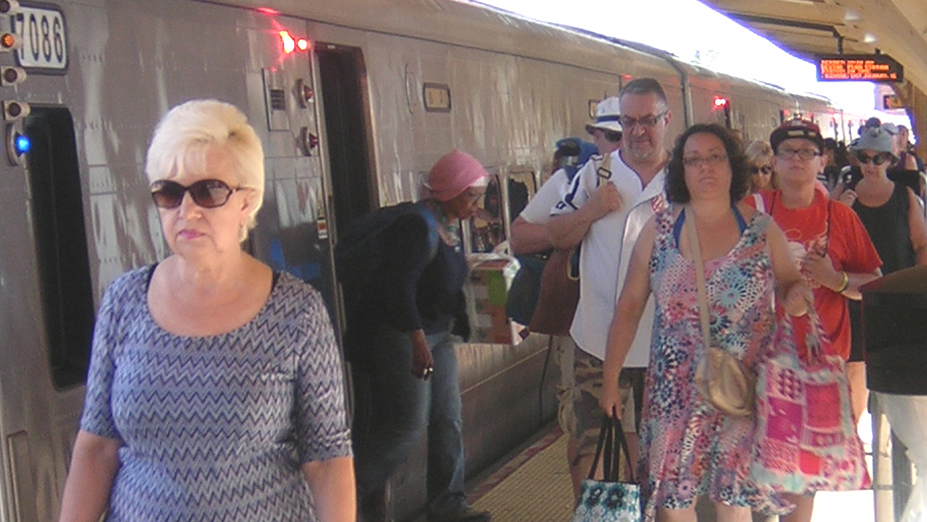As calls for funding billions of dollars in capital projects for the Metropolitan Transportation Authority go unheeded in Albany, the Long Island Rail Road Commuter Council will have their own office on Long Island for the first time since its formation. It won’t cost the LIRR a dime, which is fortunate because the railroad doesn’t have any extra money right now to spend.
In honor of the mostly symbolic occasion, the council held a ceremony on June 5 with a dozen or more local elected officials on hand to celebrate the railroad’s past, with memorabilia provided by Steven Quigley of the National Railway Historical Society’s Long Island Sunrise Trail Chapter, and to promote a better future for LIRR commuters.
“The Long Island Rail Road Commuter Council’s new office will provide a great resource for commuters,” said Nassau County Executive Mangano, who reportedly donated the 300-square-foot space on the third floor of the Ralph G. Caso Executive and Legislative Building in Mineola. “My administration looks forward to working with the Commuter Council to help enhance the rider experience for residents utilizing the Long Island Rail Road.”
The office, reportedly once used to store Nassau County real estate records, doesn’t come with a staff, according to Mark Epstein, the commuter council’s chairman. He reportedly said the group plans to hold meetings there but no schedule has yet been announced.
Founded in 1981 by the New York State Legislature as a citizens’ watchdog group, the commuter council has 11 volunteers who regularly ride the LIRR and are willing to dedicate their time to improving service and safety, and ensuring that the stations and trains are kept clean. Though their powers are only advisory, they have been able to bring problems to light and make a difference in the daily commute. Last year, the LIRR’s ridership totaled 85.8 million passengers—a 3 percent increase from 2013—and represented the third highest ridership since 1949, according to the MTA.
“I think we’ve had a number of accomplishments,” says Bill Henderson, executive director of the Permanent Citizens Advisory Committee, an advocacy group for mass transit riders that is based in Manhattan. “We improved the conditions of the stations and the hours of the stations. We’ve also gotten repairs done. One of our biggest areas has been getting more information from the railroad such as options during service diversions.”
Another improvement that Henderson’s group is taking credit for is letting riders know more accurately how long train delays will last and where on the lines they are taking place.
“Communication is a huge issue,” said Henderson, adding that “knowing what is going on with the railroad can also impact the commute.”
Along with communication, commuters are also worried about actual on-time performance and safety, especially after the recent derailments in the last year, most recently on May 12 when an Amtrak train derailed outside Philadelphia, killing eight people and leaving 200 injured.
The opening of the new office not only gives the LIRRCC a presence on the Island, but also gives the council better opportunities to establish connections with political leaders and commuters, Henderson said.
“The opening of LIRRCC’s first Long Island office will help facilitate improved communication between Council members and the riding public, allowing the commuters’ concerns to be easily heard,” said Sen. Carl L. Marcellino (R-Syosset). “This will help increase their efforts in fostering a stronger and more responsive transportation system. The LIRRCC should be commended for working to improve the quality of the service on the Long Island Rail Road.”
Throughout the year, the LIRRCC hosts “Meet the Commuter” days at different times and stations. During this event, the LIRRCC talks to riders about current issues affecting the LIRR and gets feedback on how stations could improve.
As many Long Island commuters know, many problems need to be addressed. To address public concerns over derailment issues, the LIRR says it is working on new rail cars with improved safety systems. The LIRRCC became very interested in commuter safety after learning that during the Amtrak crash in May passengers were not able to escape from the cars.
The LIRR, originally formed in 1834 to transport agricultural products, still operates essentially on the same railway infrastructure. Henderson believes the Quigley exhibit was necessary for the new LIRRCC office opening.
“It’s important to understand some of the history of the railroad,” he said. “Some of the issues [facing the LIRR] today are because of how the railroad came together.”
In addition to helping to improve service, the LIRRCC also monitors travel patterns and makes recommendations. Not as many people are commuting from suburban areas to Manhattan than in the past. Non-commuter ridership has declined by 66 percent, while commuter ridership has declined by 7 percent, according to studies.
The MTA Capital Program 2015-2019, a five-year plan pegged at $32 billion, may have started in January but it still awaits final approval by the State Legislature. Improvements are definitely needed, according to the MTA, which noted that mechanical failures have increased delays by 35 percent, and decreased economic activity by 12.8 percent.
According to the Tri-State Transportation Campaign, a nonprofit mass transit advocacy group based in Manhattan, more than 60 percent of the new 2015 capital program will be devoted to maintaining the LIRR infrastructure as well as making the rail cars safer. The capital program will also focus on improving station platforms at Babylon, Nostrand Avenue and Hunterspoint Avenue, which could cost $380 million, completing a double track between Farmingdale and Ronkonkoma to eliminate delays when trains break down, and building a new station in Elmhurst.
The East Side Access is the first expansion of the LIRR in more than a century. Once finished, it will allow the LIRR to connect to Grand Central Terminal and reduce the travel time by 30 to 40 minutes each way for an estimated 160,000 riders daily. The ambitious project was originally planned to be completed by 2009 and cost $4.3 billion, according to the state comptroller’s office, but its completion date has been extended four times in 10 years while the price tag has kept going up. Now, the East Side Access is expected to be done by 2023 and run $10.8 billion.
With Spencer Rumsey



























